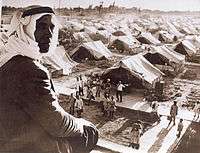Palestinian refugee camps
Palestinian refugee camps are camps set up by the United Nations Relief and Works Agency (UNRWA) in Jordan, Lebanon, Syria, the West Bank and the Gaza Strip to accommodate Palestinian refugees registered with UNRWA, who fled or were expelled during the 1948 Palestinian exodus after the 1948 Arab–Israeli War or in the aftermath of the Six-Day War in 1967, and their patrilineal descendants.[1] There are 59 registered Palestinian refugee camps, ten of which were established after the Six-Day War while the others were established in 1948 to 1950s.
| 1948 Palestinian exodus |
|---|
 |
| Main Articles |
|
| Background |
| Key incidents |
| Notable writers |
|
| Related categories/lists |
|
| Related templates |
|
The number of registered Palestine refugees has grown from 750,000 in 1950 to around 5 million in 2013.[2] Many Palestinian refugees have remained in Palestinian refugee camps to this day, while others have been absorbed into Jordanian society or the Palestinian territories.
Definition of Palestinian refugee
UNRWA’s mandate is to provide assistance to Palestinian refugees, including access to its refugee camps. For this purpose, it defines a Palestinian refugee as:[2]
- "persons whose normal place of residence was Palestine during the period 1 June 1946 to 15 May 1948, and who lost both home and means of livelihood as a result of the 1948 conflict."
UNRWA also extends assistance to the patrilineal descendants of such refugees, as well as their legally adopted children.[2]
Role of UNRWA
For a camp to be recognized by UNRWA, there must be an agreement between the host government and UNRWA governing use of the camp. UNRWA does not itself run any camps, has no police powers or administrative role, but simply provides services to the camp. UNRWA recognizes facilities in 59 designated refugee camps in Jordan, Lebanon, Syria, the West Bank and the Gaza Strip, and it also provides facilities in other areas where large numbers of registered Palestine refugees live outside of recognized camps. UNRWA also provided relief to Jewish displaced persons inside Israel following the 1948 conflict until the Israeli government took over responsibility for them in 1952. Refugee camps developed from tented cities to rows of concrete blockhouses to urban ghettos indistinguishable from their surroundings (effectively becoming urban developments within existing cities or by themselves), that house around one third of all registered Palestine refugees.
The funding for UNRWA activities comes almost entirely from voluntary contributions from UN member states. UNRWA also receives some funding from the Regular Budget of the United Nations, which is used mostly for international staffing costs.[2]
List of camps
| Part of a series on |
| Palestinians |
|---|
 |
| Demographics |
| Politics |
|
| Religion / religious sites |
| Culture |
| List of Palestinians |
This lists the current Palestine refugee camps with the 2014 population and year they were established.[2]
Gaza Strip
The Gaza Strip has 8 refugee camps and 1,221,110 registered refugees.
- 1948, Al-Shati (Beach camp), 87,000
- 1949, Bureij, 34,000
- 1948, Deir al-Balah Camp, 21,000
- 1948, Jabalia Camp, 110,000
- 1949, Khan Yunis Camp, 72,000
- 1949, Maghazi, 24,000
- 1949, Nuseirat Camp, 66,000
- 1949, Rafah Camp, 104,000
West Bank
The West Bank has 19 refugee camps and 741,409 registered refugees. One camp is unofficial (*).
- 1948, Aqabat Jaber, 6,400
- 1948, Ein as-Sultan, 1,900
- 1948, Qaddura camp*, 1,558
- 1949, Far'a, 7,600
- 1949, Fawwar, 8,000
- 1949, Jalazone, 11,000
- 1949, Kalandia, 11,000
- 1949, Am'ari, 10,500
- 1949, Deir 'Ammar Camp, 2,400
- 1949, Dheisheh, 13,000
- 1950, Aida, 4,700
- 1950, Al-Arroub, 10,400
- 1950, Askar, 15,900
- 1950, Balata, 23,600
- 1950, 'Azza (Beit Jibrin), 1,000
- 1950, Ein Beit al-Ma' (Camp No. 1), 6,750
- 1950, Tulkarm camp, 18,000
- 1952, Nur Shams, 9,000
- 1953, Jenin camp, 16,000
- 1965, Shuafat camp, 11,000
Syria
Syria has 13 refugee camps and 499,189 registered refugees. Three of these camps are unofficial (*).
- 1948, Sbeineh, 22,600
- 1949, Khan Eshieh, 20,000
- 1948, Neirab, 20,500
- 1949, Homs, 22,000
- 1948, Jaramana camp, 18,658
- 1950, Deraa camp, 10,000
- 1950, Hama camp, 8,000
- 1950, Khan Dannun, 10,000
- 1967, Qabr Essit, 23,700
- 1955-6, Latakia Camp*, 10,000
- 1957, Yarmouk*, 148,500
- 1962, Ein Al-Tal*, 6,000, also known as Handarat camp
Lebanon
There are 12 refugee camps in Lebanon and 448,599 registered refugees.
- 1948, Bourj el-Barajneh, 17,945
- 1948, Ain al-Hilweh, 54,116
- 1948, El Buss, 11,254
- 1949, Nahr al-Bared, 5,857
- 1949, Shatila, 9,842
- 1948, Wavel, 8,806
- 1952, Mar Elias, 662
- 1954, Mieh Mieh, 5,250
- 1955, Beddawi, 16,500
- 1955, Burj el-Shemali, 22,789
- 1956, Dbayeh camp, 4,351
- 1963, Rashidieh, 31,478
Jordan
There are 10 refugee camps in Jordan and 2,034,641 registered refugees.
- 1949, Zarqa camp, 20,000
- 1951, Irbid camp, 25,000[3]
- 1952, Jabal el-Hussein, 29,000
- 1955, Amman New Camp (Wihdat), 51,500
- 1967, Souf refugee camp, 20,000
- 1968, Baqa'a refugee camp, 104,000
- 1968, Husn Camp (Martyr Azmi el-Mufti camp), 22,000
- 1968, Jerash camp, 24,000
- 1968, Marka, 53,000
- 1968, Talbieh Camp, 7,000
See also
References
- UNWRA, Palestine refugees
- "Who We Are - UNRWA". UNRWA. Retrieved 8 January 2014.
- UNRWA Irbid Camp
External links
| Wikimedia Commons has media related to Palestinian refugee camps. |
- Palestinian Refugees in Lebanon
- Palestinian Refugees in Syria
- Palestinian Refugees in Jordan
- As rebuilding begins at lebanon's nahr al bared, displaced refugees are eager to return, William Wheeler and Don Duncan, World Politics Review, 11 March 2008
- UN refugee agency unveils Palestinian archive